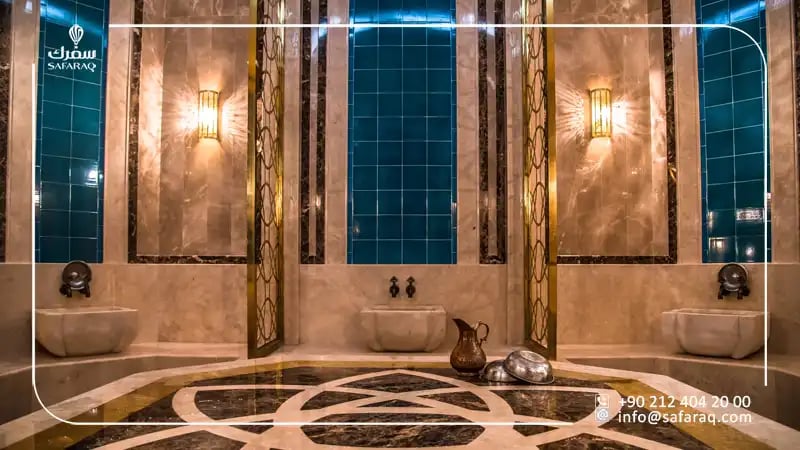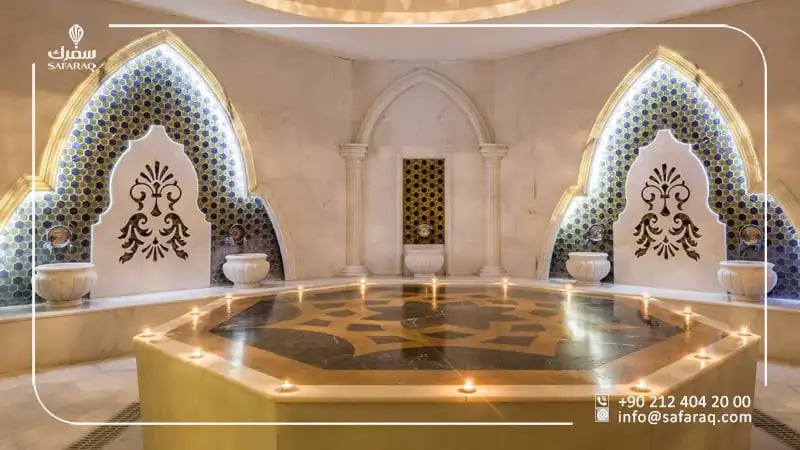Traditional Turkish Bath Experience from Start to Finish

- Historical Background of the Turkish Bath
- Design and Facilities of the Turkish Bath
- Detailed Turkish Bath Experience
- Health and Beauty Benefits of the Turkish Bath
- Differences Between the Turkish Bath, Sauna, and Moroccan Hammam
- Top Places to Experience a Turkish Bath
Historical Background of the Turkish Bath
The Turkish bath has deep historical roots, dating back to ancient Roman and Byzantine baths, before evolving and flourishing during the Ottoman era to become an essential part of daily life. It was not merely a place for physical hygiene, but it served as a social hub where people of all classes gathered to chat and participate in traditional rituals.
During the Ottoman period, baths were often built next to mosques and markets, with designated days for men and others for women. For women, a visit to the bath was a celebratory occasion accompanied by adornment, music, and delightful conversations. Over time, the Turkish bath retained its status and transformed from a daily necessity into a distinctive tourist experience sought by visitors from all over the world.

Design and Facilities of the Turkish Bath
The design of the Turkish bath is based on a carefully planned thermal layout that moves through several stages, beginning with a cool room and ending in a steam-filled hot room. Upon entering, the visitor begins in the changing room, where they put on the traditional cotton wrap called "pestemal." They then proceed to the warm room, which gradually acclimates the body to higher heat.
At the center of the bath lies the main hot room, known as the steam room or "hararet," covered entirely in marble. At its center is a large, heated marble platform called the "göbektaşı" or navel stone, where visitors lie down to warm up and sweat. Surrounding the platform are copper basins and sinks used for pouring warm water.
The interior design strikes a balance between luxury and simplicity, utilizing soft lighting and harmonious architecture to create a relaxing and peaceful atmosphere.
Detailed Turkish Bath Experience
The traditional Turkish bath experience follows several integrated stages, starting from preparation and ending with complete relaxation. Here are the steps of the experience clearly explained:
- Reception and Preparation: Upon arrival, visitors are warmly welcomed by staff and given a cotton wrap (pestemal) and wooden slippers, then directed to the changing room.
- Steam Room Phase: After changing, the visitor enters the steam room for 10 to 20 minutes. This stage helps open the pores and soften the skin in preparation for exfoliation.
- Traditional Scrubbing (Kese): A coarse mitt called a “kese” is used by an attendant to scrub the body in circular motions, removing dead skin and stimulating blood circulation.
- Foam Massage: The body is then covered in thick foam using natural olive oil or laurel soap, followed by a gentle massage that enhances relaxation and leaves the skin incredibly soft.
- Rinsing with Lukewarm Water: After the massage, the body is rinsed with warm water to remove the foam and cleanse the skin, leaving a refreshing and clean sensation.
- Optional Oil Massage: In some baths, an additional massage session is offered using aromatic oils for deeper muscle relaxation and sensory enjoyment.
- Final Relaxation: The experience concludes with a rest period in a quiet room, where guests enjoy a glass of Turkish tea or cold juice to complete the tranquil moment.
With these integrated steps, a visit to the Turkish bath becomes a holistic ritual that combines body care with mental relaxation.
Health and Beauty Benefits of the Turkish Bath
The Turkish bath is more than a leisure activity; it offers tangible health and beauty benefits noticeable from the first session. Below are the most prominent advantages explained in detail:
- Stimulates Blood Circulation: The heat in the steam room helps dilate blood vessels and boost circulation, increasing oxygen delivery to tissues and enhancing overall vitality.
- Skin Renewal: Scrubbing with the traditional kese removes layers of dead skin and stimulates new cell growth, leaving the skin smooth and naturally radiant.
- Detoxification: Sweating heavily in the steam room helps expel accumulated toxins from the body, promoting a sense of inner lightness and purity.
- Relieves Muscle and Joint Tension: The moist heat and foam massage help relieve muscle spasms and joint pain caused by fatigue or daily stress.
- Mental Relaxation: The calm atmosphere, dim lighting, natural aromas, and warm foam all contribute to creating a perfect environment for mental and emotional tranquility.
- Enhances Beauty Treatments: The Turkish bath is a popular pre-treatment at spas, as it prepares the skin to better absorb oils, masks, or other cosmetic products.
Thus, the Turkish bath is not just a way to get clean—it’s a complete wellness and rejuvenation ritual for both body and mind.

Differences Between the Turkish Bath, Sauna, and Moroccan Hammam
Although the Turkish bath, sauna, and Moroccan hammam share similarities as methods of relaxation and cleansing, each has its unique characteristics. The Turkish bath uses moist heat and hot steam, whereas the sauna relies on dry heat in wooden rooms, affecting how the body sweats and responds to temperature.
The Moroccan hammam, on the other hand, uses Moroccan clay and black soap, with less intense steam and a stronger focus on deep exfoliation using rough gloves. While the Turkish bath offers a comprehensive experience with a heated marble platform, rich foam massage, and luxurious marble setting, the sauna leans toward simplicity and privacy, and the Moroccan hammam emphasizes deep skin cleansing.
Each type has its audience, but the Turkish bath remains the most globally recognized for its regal atmosphere and step-by-step ritual.
Top Places to Experience a Turkish Bath
Choosing the right location for a Turkish bath adds another dimension to this traditional ritual. Some baths combine history and grandeur, while others offer modern luxury experiences to suit today’s tastes.
- Çemberlitaş Hamamı (Istanbul): Built in the 16th century by the famous Ottoman architect Mimar Sinan, this bath stands out for its majestic, classical design and offers a full traditional experience.
- Cağaloğlu Hamamı (Istanbul): Located in the historic center near Hagia Sophia, it is one of Turkey’s oldest baths and offers a refined atmosphere blending Ottoman heritage with exceptional service.
- Sultan Murat Bath (Bursa): Known for its natural sulfur-rich waters, this bath offers a unique therapeutic experience and attracts those seeking health and natural healing.
- Antalya Baths: This coastal city provides a mix of traditional and modern services, making it a great option for those who prefer a luxurious spa setting within a resort.
- Hotel Luxury Hammams: Many five-star hotels across Turkey offer modern Turkish baths equipped with all the comforts and hygienic standards, providing a premium experience for guests of all ages.
These diverse options allow visitors to explore the richness of Turkish bath culture, from historic settings to high-end wellness centers.

Book a Free Travel Consultation with Safaraq Tourism
If you're planning a trip to Turkey and want an authentic and unforgettable experience, don’t miss the opportunity to try a traditional Turkish bath in Istanbul, Antalya, or Bursa. To make your experience smoother and more organized, you can rely on our company, Safaraq Tourism, which specializes in tourism within Turkey.
Book your free consultation now with the Safaraq Tourism team and let us design a unique experience for you in the heart of Turkish culture—from the moment you enter the bath to the final drop of warm water relaxing your body.
Featured tourist services
We offer top tourist services with the highest standards of quality and luxury with 24/7 follow-up.

Flight reservations

Tourist programs

Hotels and Resorts

Car Reservation

Group Tours

VIP Services
Subscribe To Our Newsletter
Find More About The Latest Safaraq






















 Home
Home




